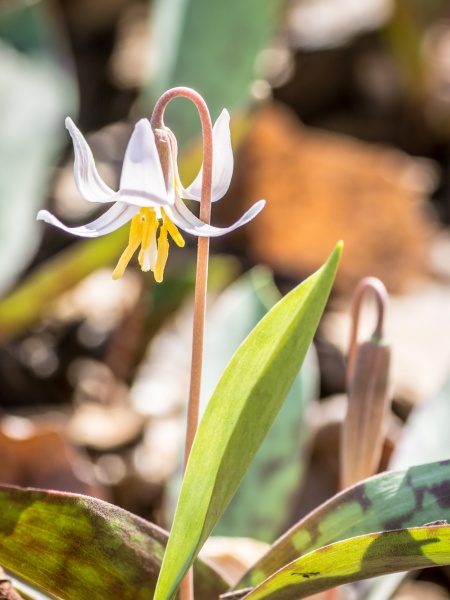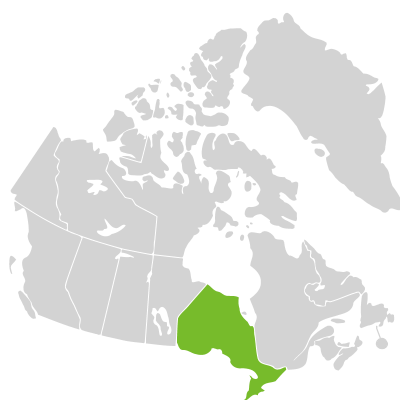
Source: Andrew C
Erythronium albidum
White Trout Lily
Érythrone blanchâtre
Synonyms
small white fawn lily
white adder's-tongue
white dog's-tooth violet
No seeds available for this plant.
We currently accept seeds for this plant
Bloom Colour: White
Bloom Period: Apr - Apr
Max Height: 1.0 feet
Max Width: 0.5 feet (spreads by rhizome)
Light Condition:
 Less than 2 or 3 hours of direct sun a day
Soil conditions:
Less than 2 or 3 hours of direct sun a day
Soil conditions:
 Tolerates medium soil condition
Tolerates medium soil condition
 Less than 2 or 3 hours of direct sun a day
Less than 2 or 3 hours of direct sun a day
 Tolerates medium soil condition
Tolerates medium soil condition
Lifespan:
Perennial
plants that will that come back year after year
(Spring Ephemeral)
Gardener Experience:
 Does not spread uncontrollably
Does not spread uncontrollably
 Does not spread uncontrollably
Does not spread uncontrollably
Landscape Uses:
 Suitable for container garden
Suitable for container garden
 Suitable for woodland gardens
Suitable for woodland gardens
 Suitable for container garden
Suitable for container garden
 Suitable for woodland gardens
Suitable for woodland gardens
Ecological Benefits:
 Bee host
Bee host
 Bee host
Bee host
Tolerates:
 Deer resistant
Deer resistant
 Rabbit resistant
Rabbit resistant
 Tolerates juglone conditions
Tolerates juglone conditions
 Deer resistant
Deer resistant
 Rabbit resistant
Rabbit resistant
 Tolerates juglone conditions
Tolerates juglone conditions
Special Features and Considerations:
 This plant causes skin rashes
This plant causes skin rashes
 This plant causes skin rashes
This plant causes skin rashes
Plant Location
Distribution according to VASCAN

Ephemeral
Native
Introduced
Excluded
Extirpated
Doubtful
Absent
Thrives in Ecozones
- Boreal Plains
- Mixed Wood Plains
Ecological Benefits
Butterflies Supported by Erythronium albidum
No butterfly data available for this plant.
Specialized Bees Supported by Erythronium albidum
- Andrena erythronii
Plants that grow in similar conditions, that bloom at the same time.
Complementary Plants
- Anemone parviflora
Small-flowered Anemone
Anémone à petites fleurs - Gaultheria procumbens
Eastern Teaberry
Thé des bois - Trillium erectum
Red Trillium
Trille rouge - Trillium grandiflorum
White Trillium
Trille blanc - Viola sororia
Woolly Blue Violet
Violette parente
Substitute For Non-Native Plants
- Convallaria majalis (Lily of the Valley)
- Lysimachia nummularia (Creeping Jenny)
- Iridaceae (Crocus)
- Scilla siberica (Siberian Squill)
- Tulipa (Tulips)
- Funkia (Hosta)
- Vinca major and Vinca minor (Periwinkle)
Sowing Information
Download Seed Envelope Labels (PDF)
- Sowing depth: Sow just below surface
- Sow anytime
- Stratification duration: 0 days
- Notes: Double dormancy.
Harvesting and Seed Sharing
- Harvest start month: June
- Harvesting indicator:
- Pods are brown and slightly open
- Harvesting:
- Open the pod, remove seeds
- Seed viability test:
- No test needed before donating
- Packaging measure: Six (6) seeds (eyeball)
- Seed storage:
- Keep moisten and cool, in a ziploc bag, in the fridge, with the seeds in soil, paper towel or coffee filter, until donation
- Cultivar: Yes, do not donate unless you know source, and there are no known cultivars in your garden or at proximity
- Remove non-seed material
- No harvesting video available at this time.
Toxicity Notes
Not known to be toxic to cats or dogs if ingested.


 Canadensis
Canadensis
